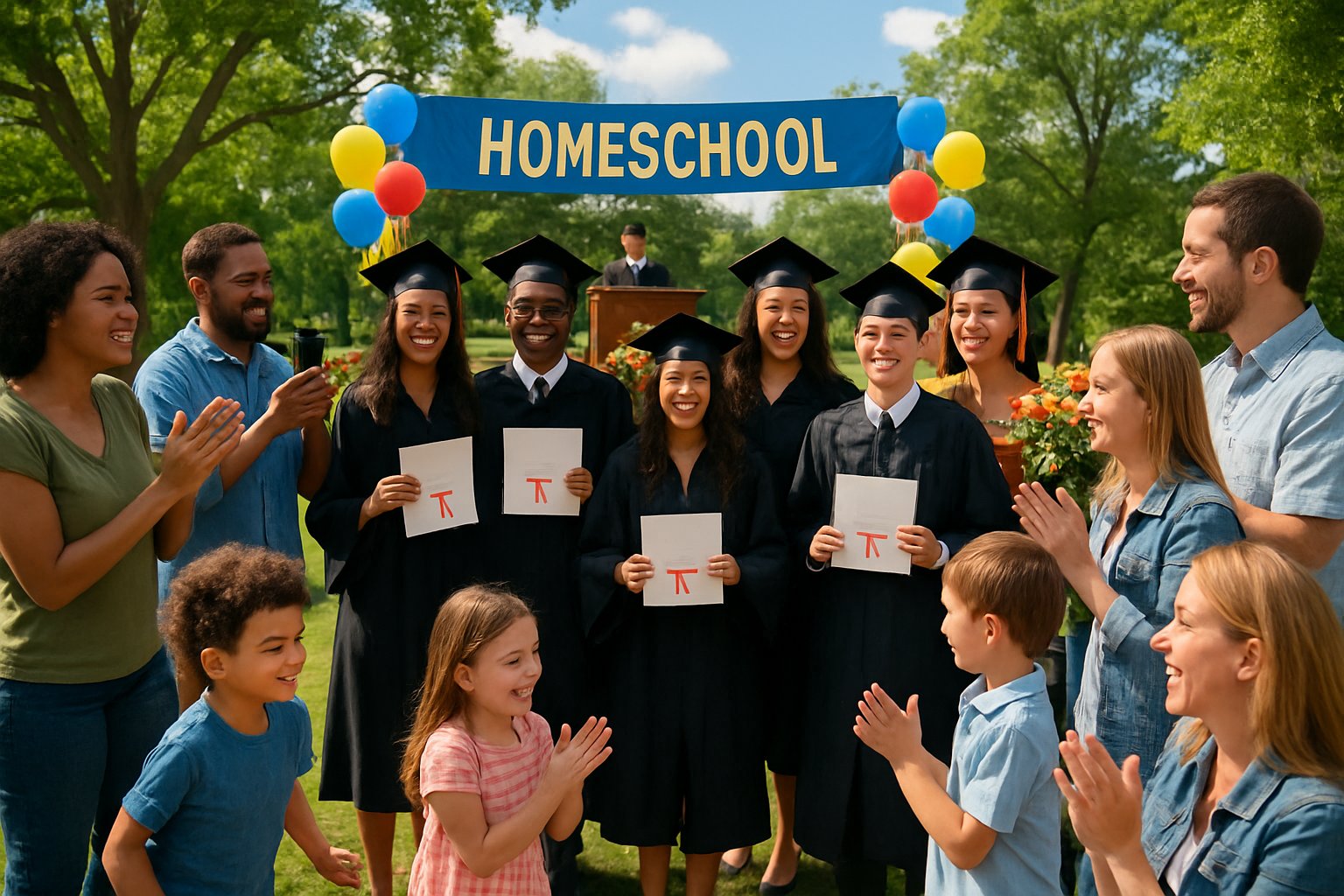Establish Graduation Requirements

Families who homeschool often need to set clear expectations before planning a graduation. They must decide what academic work counts, make sure they follow state rules, and choose a date that works for both the student and the guests.
Determine Academic Criteria
Homeschoolers should first decide what coursework and credits will qualify a student for graduation. Many families use the same structure as public schools, such as four years of English, three to four years of math, and a mix of science, history, and electives.
Some parents create a transcript that lists completed courses, grades, and credits earned. This record helps if the graduate applies to college, trade school, or the military.
It can also be helpful to set goals beyond academics. For example, families may include volunteer hours, job experience, or personal projects as part of the graduation requirements. These additions give a fuller picture of the student’s high school experience.
Review State Homeschooling Laws
Each state has its own rules about homeschooling high school and graduation. Some states require parents to file annual reports or keep detailed records, while others leave most of the responsibility to the family.
Parents should check their state’s department of education website or a trusted homeschool organization to confirm what is needed. For example, HSLDA offers guidance on planning homeschool graduations and outlines how state laws may affect requirements.
In some states, parents can issue a diploma without outside approval. In others, homeschoolers may need to register with a local district or umbrella school. Knowing these details early prevents last-minute problems and ensures the diploma is recognized.
Select Graduation Date
Choosing a graduation date gives the family a clear timeline to finish coursework and prepare for the ceremony. Many homeschoolers hold graduations in late spring or early summer, but the exact timing depends on the student’s schedule.
It’s best to set the date several months in advance, especially if renting a venue or inviting extended family. Guidance from resources like 7 Sisters Homeschool suggests booking locations early since June can be busy with weddings and other graduations.
Families should also consider practical details, like travel plans for relatives, availability of caps and gowns, and how much time is needed to finish final assignments. A set date helps keep the student on track and makes the event feel official.
Design the Graduation Ceremony

Families can shape a homeschool graduation ceremony to fit their student’s personality, available space, and guest list. Planning involves choosing the right format, arranging a location that feels meaningful, and creating a clear flow of events so the day runs smoothly.
Choose Ceremony Format
The first step is deciding how formal or casual the graduation should be. Some families prefer a structured event with speeches, caps and gowns, and a diploma presentation. Others enjoy a relaxed gathering that blends a short ceremony with a party.
A homeschool group may host a joint ceremony for multiple graduates. This option provides a larger audience, shared responsibilities, and a more traditional feel. Families who want a personal touch often plan a private event at home, inviting only close relatives and friends.
It helps to think about what the graduate values most. If they want a moment to shine, a stage and microphone may be important. If they prefer simplicity, a living room or backyard ceremony can be just as meaningful. The chosen format should reflect the graduate’s preferences, not outside expectations.
Select Venue and Setup
The venue sets the tone. A family can reserve a church hall, community center, or park pavilion for a larger group. For smaller gatherings, the backyard, living room, or even a rented room at a library can work well. Choosing early is important, especially if the location requires reservations.
Setup should include seating for guests, a space for the graduate to walk in, and a spot for photos. A podium or small table can hold the diploma. Decorations like banners, flowers, or a memory board help personalize the space.
Families who want to keep costs low often use simple touches such as balloons or printed signs. A homeschool graduation ceremony doesn’t need to be elaborate to feel special. What matters most is creating a comfortable place where the graduate feels celebrated.
Plan the Order of Events
A clear schedule keeps the ceremony organized. Most events include:
- Welcome message from a parent or organizer
- Opening remarks or prayer (optional)
- Graduate recognition and diploma presentation
- Short speech from the graduate or parent
- Closing words and transition to photos or party
Some families add music, a slideshow, or recognition of achievements. Others keep it short and focused.
When planning with a homeschool group, it helps to assign roles such as emcee, photographer, or program coordinator. This avoids confusion and ensures each part of the ceremony flows smoothly.
Families hosting at home can keep the order simple. Even a short ceremony with a diploma handoff, applause, and photos can feel complete when it is planned with care.
Personalize the Celebration
A homeschool graduation feels more meaningful when it reflects the graduate’s life, family values, and accomplishments. Families can shape the event with traditions, heartfelt words, and displays that highlight the student’s unique journey.
Incorporate Family Traditions
Families often want the ceremony to reflect their own culture and values. This can include opening with a favorite prayer, lighting a candle, or sharing a family song. Some homeschoolers choose to include a symbolic gesture, such as presenting a keepsake or passing down a family heirloom.
Food is another way to bring in tradition. Serving a favorite meal or dessert at the reception creates comfort and familiarity. Parents may also decorate with colors or themes that hold personal meaning.
A helpful idea is to create a short list of traditions and decide which ones fit well into the ceremony. Keeping it simple avoids overwhelming the schedule while still making the event personal. Families can look at examples of unique homeschool graduation ideas for inspiration.
Prepare Speeches and Presentations
Personal speeches add warmth to a homeschool graduation. Parents often give a short address to their graduate, sharing memories and encouragement. This moment is usually one of the most touching parts of the ceremony.
Graduates may also prepare their own speech to thank parents, mentors, or friends. Some families invite a close relative or trusted teacher to speak as well. Keeping speeches between 3–5 minutes ensures the program stays focused.
Visual presentations can also add meaning. A slideshow of photos with music or short video clips lets guests see the graduate’s growth over the years. Families planning a group event can follow structured tips like those in step-by-step homeschool graduation guides to organize speakers and presentations.
Display Achievements and Memories
Displaying the graduate’s work and accomplishments gives guests a clear picture of their homeschool journey. A memory table can include awards, art projects, essays, or science fair photos. Some families also showcase sports medals, volunteer certificates, or musical instruments.
Adding personal touches helps guests connect with the graduate’s story. A scrapbook or poster board with photos from field trips, co-op classes, and family activities works well.
Graduates can also set up a digital slideshow or memory wall. For larger gatherings, families may follow suggestions from creative homeschool graduation celebrations to design displays that highlight both academic and personal milestones.
Organize Graduation Essentials
Families often focus on the visible details that make a graduation feel official. Items like the cap and gown, diploma, and traditional music play a big role in creating a ceremony that feels both personal and meaningful.
Order Cap and Gown
The cap and gown symbolize the student’s achievement and add a sense of tradition. Families can choose classic black or select colors that match the student’s style or future school. Many companies allow bulk orders, but single sets are also available for homeschool graduates.
It helps to order early, at least two months before the ceremony, to avoid delays. Sizes vary, so checking height and weight charts is important. Caps often come with a tassel, which can be customized with the graduation year.
Some families rent caps and gowns, but purchasing ensures a keepsake for photos or future events. A simple ironing or steaming before the ceremony keeps the gown looking neat. Including a stole or honor cord can highlight special achievements or activities.
Prepare Diplomas
A diploma gives the graduate a tangible reminder of their hard work. Parents can create their own using templates, or they can order custom-printed diplomas from homeschool organizations. Both options are widely accepted for personal records and college applications.
Diplomas often include the graduate’s full name, the date of graduation, and the name of the homeschool. Some families add signatures from both parents or a homeschool leader. Decorative covers protect the document and make presentation during the ceremony more formal.
For families with multiple graduates, preparing diplomas ahead of time avoids last-minute stress. It also allows time to double-check spelling and formatting. A diploma presented in front of family and friends gives the ceremony a professional touch.
Arrange for Pomp and Circumstance
Playing Pomp and Circumstance adds a traditional element that signals the start of the ceremony. Families can use a recorded version, which is easy to play on a speaker, or invite a musician to perform it live.
The music usually begins as the graduate walks in wearing the cap and gown. Timing the song to match the pace of the entrance makes the moment feel organized.
If the family prefers a personal touch, they may choose a different piece of music. However, many still select Pomp and Circumstance because it creates a recognizable and formal atmosphere. This small detail helps the event feel complete and memorable.
Announce and Celebrate
Families often want to share the graduate’s achievement with relatives and friends while also creating a special event to mark the milestone. Taking time to send out formal notices and planning a thoughtful gathering helps make the occasion memorable and meaningful.
Send Graduation Announcements
Graduation announcements let family, friends, and community members know about the student’s accomplishment. These can be mailed, handed out in person, or even sent digitally if preferred.
Some families design custom cards with the graduate’s name, photo, and homeschool details. Others keep it simple with a printed template. Adding the ceremony date, time, and location ensures guests have all the information they need.
It helps to order announcements early. This allows time for printing, addressing, and mailing without stress. Parents may also want to include a short personal note or a favorite quote from the graduate.
For those who want more ideas, families can look at how others plan homeschool graduations to see examples of announcements and ceremony details. Keeping the design personal while still clear and professional makes the announcement both practical and memorable.
Host a Graduation Party
A graduation party gives the graduate a chance to celebrate with the people who supported them. It can be as simple as a backyard cookout or as formal as a rented hall with decorations and music.
Planning starts with choosing a location, guest list, and menu. Some families prefer a casual potluck, while others hire catering. A reception-style setup with finger foods often works well for larger groups.
Adding personal touches makes the party stand out. Displaying a photo board, slideshow, or memory table helps guests reflect on the graduate’s journey. Parents may also prepare a short speech to honor the student.
For ideas on combining both ceremony and reception, families can see how others host a homeschool graduation ceremony. Whether large or small, the party should reflect the graduate’s personality and achievements.
Leave a Reply